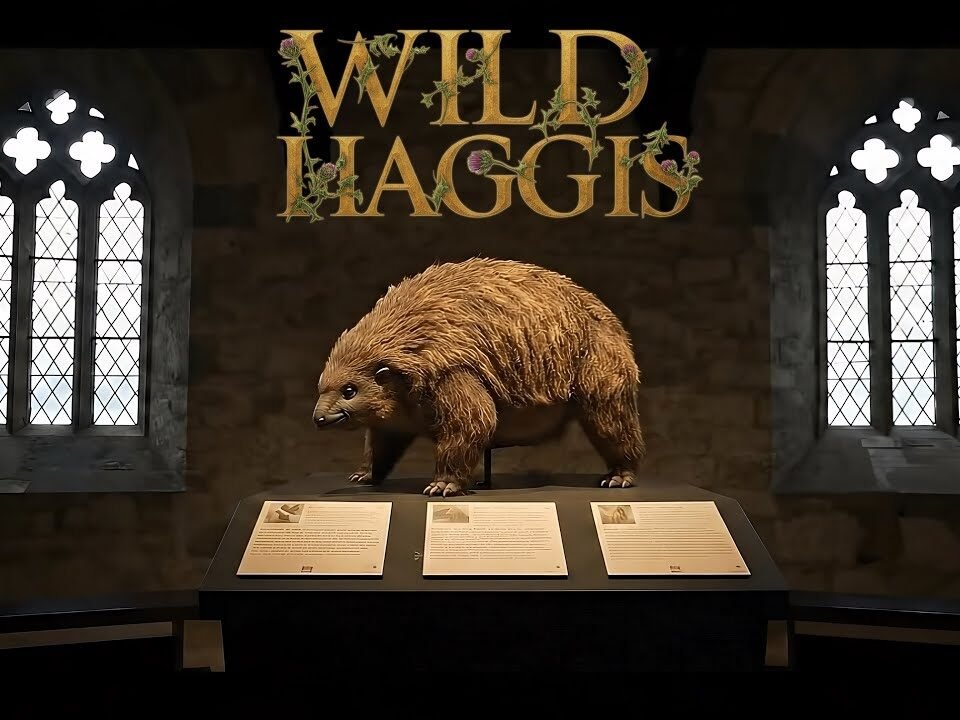
Scotland’s Wild Haggis – The Perfect Scottish Gift
November 10, 2023
Wild Haggis and the Conservation Chronicles
December 7, 2023The Intriguing Taxonomy of the Wild Haggis
In the realm of taxonomy, the science of classifying and naming species, the Haggis presents a unique and fascinating case. Found primarily in Scotland, this elusive creature has long been a subject of interest for both enthusiasts and pseudo-scientists. Today, we explore the taxonomy of the Haggis with the rigor and seriousness it deserves.
The Edinburgh Haggis Assembly
As an example of how this works, take for instance the rare sighting of three Highland Haggis and a single Lowland Haggis congregating on a Tuesday in Edinburgh. In accordance with the traditions of Latin-based taxonomy, this grouping would be termed ‘Tertius Haggis Altus Trio et Unus Haggis Humilis Edinburgensis.’ This nomenclature carefully categorizes the creatures based on number, regional habitat, and location:
- ‘Tertius’ indicates the number three, referring to the Highland Haggis.
- ‘Haggis Altus Trio’ identifies these as Highland variants, suggesting a specific geographic and perhaps behavioural distinction.
- ‘Unus Haggis Humilis’ singles out the one Lowland Haggis, denoting its different origin.
- ‘Edinburgensis’ precisely locates this unusual gathering in Edinburgh.
Through such detailed classification, we gain a deeper understanding of the Haggis, a creature shrouded in mystery and rich in cultural significance. The study of Haggis taxonomy not only provides insight into their diverse habitats and behaviors but also enriches our appreciation of Scotland’s natural heritage.
Solitary Highland Haggis in Winter
Latin Name: Haggis Altus Solitarius Hiemalis
Description: A lone Highland Haggis observed during the winter months, displaying unique behaviors adapted to colder climates.
Pair of Lowland Haggis During Mating Season
Latin Name: Duo Haggis Humilis Amoris Tempore
Description: Two Lowland Haggis found together during the mating season, showcasing courtship rituals and bonding behaviors.
Family of Haggis Crossing a Stream
Latin Name: Familia Haggis Aquaticus Transitus
Description: A family unit of Haggis, including both adults and juveniles, navigating across a stream, demonstrating their ability to adapt to various terrains.
Group of Young Haggis Playing
Latin Name: Juvenes Haggis Ludus Cohortis
Description: A lively group of young Haggis engaged in play, an essential activity for their social development and learning.
Gathering of Haggis During Migration
Latin Name: Congregatio Haggis Migratorius
Description: A large gathering of Haggis observed during their seasonal migration, a rare event that involves complex navigational skills.
Elder Haggis in a Reflective Pose
Latin Name: Haggis Senex Contemplatio
Description: An older Haggis seen in a solitary, reflective stance, possibly indicative of wisdom and life experience within the Haggis community.
Platonic Haggis Discoursing on Forms
Latin Name: Haggis Platonicus Formarum Disputatio
Description: A gathering of Haggis observed in deep discussion, reminiscent of Plato’s dialogues. They seem to ponder the nature of ‘ideal forms,’ questioning the essence of Haggis-ness in a higher realm.
Haggis in Tragicomic Dilemma
Latin Name: Haggis Shakespeareanus Tragicomicus Dilemma
Description: A lone Haggis enacting a scene that echoes the tragicomic elements of Shakespeare’s plays. Its actions suggest a profound internal conflict, embodying the complexity of characters like Hamlet.
Haggis Trio Emulating Socratic Method
Latin Name: Trio Haggis Socraticus Methodus
Description: Three Haggis are seen engaging in a methodical debate, mirroring the Socratic method of questioning. This assembly reflects a quest for truth and understanding through persistent inquiry.
Haggis Reenacting a Scene from Dante’s Inferno
Latin Name: Haggis Dantes Inferno Scenam Reagens
Description: A group of Haggis is found in a formation that strikingly resembles a scene from Dante’s Inferno, possibly representing the journey through different realms of consciousness.
Haggis Assembly Reflecting Orwellian Dystopia
Latin Name: Conventus Haggis Orwellianus Dystopia
Description: A congregation of Haggis arranged in a manner that subtly mirrors the themes of George Orwell’s dystopian narratives, suggesting commentary on surveillance and control.
Haggis Pair Echoing Romeo and Juliet’s Balcony Scene
Latin Name: Duo Haggis Romeo Juliet Balcone Scena
Description: Two Haggis seen in an arrangement reminiscent of the iconic balcony scene from Romeo and Juliet, reflecting the timeless themes of love and destiny.
Haggis Enacting Aristophanean Comedy
Latin Name: Haggis Aristophaneus Comedia Actuans
Description: A group of Haggis observed in a playful and intricate interaction, evoking the style of Aristophanes’ ancient comedies, commenting on social and political issues of their world.
Haggis Tableau Vivant of Da Vinci’s Last Supper
Latin Name: Haggis Da Vinci Cena Ultima Tableau Vivant
Description: Haggis positioned in a way that strikingly resembles Leonardo da Vinci’s “The Last Supper,” creating a tableau that bridges art, history, and the natural world.
Haggis Feeding on Highland Flora
Latin Name: Haggis Herbivorus Altus Alimentum
Description: Haggis found feeding on the unique flora of the Highlands, highlighting their dietary habits and ecological role.
Nocturnal Haggis Under a Full Moon
Latin Name: Haggis Nocturnus Luna Plena
Description: Haggis observed during nocturnal activities under the light of a full moon, revealing their adaptability to different light conditions.
Haggis Flock in Early Morning Mist
Latin Name: Greges Haggis Matutinus Nebula
Description: A group of Haggis seen wandering through the early morning mist, a common sighting in the damp, hilly regions they inhabit.
Haggis Herd Grazing on a Highland Meadow
Latin Name: Armentum Haggis Pratum Altus
Description: A herd of Haggis observed grazing peacefully on the lush meadows of the Highlands, a testament to their herbivorous lifestyle.
Juvenile Haggis Learning to Forage
Latin Name: Haggis Juvenilis Discens Forragium
Description: Young Haggis accompanied by adults, learning the essential skill of foraging, crucial for their survival in the wild.
Haggis Quartet in Homeric Odyssey
Latin Name: Quartetum Haggis Homericus Odyssea
Description: Four Haggis embarking on an adventurous journey, reminiscent of the trials and tribulations faced by Odysseus in Homer’s Odyssey, symbolizing resilience and the quest for home.
Haggis Reenacting Chaucer’s Canterbury Tales
Latin Name: Haggis Chaucerius Cantuariensis Fabulae
Description: A group of Haggis representing various characters from Chaucer’s Canterbury Tales, each depicting a different facet of medieval society and human nature.
Haggis Depicting Machiavellian Strategy
Latin Name: Haggis Machiavellianus Strategia
Description: A Haggis observed in a solitary contemplative pose, suggesting the cunning and strategic depth of Machiavelli’s political treatises.

Haggis in a Kafkaesque Scenario
Latin Name: Haggis Kafkaesus Absurdum Scenarium
Description: A lone Haggis in a setting that embodies the surreal and absurd nature of Kafka’s narratives, touching on themes of existential angst and the bizarre.
Haggis Ensemble Echoing Beethoven’s Symphony
Latin Name: Consortium Haggis Beethovenianus Symphonia
Description: A group of Haggis arranged in a harmonious formation, mimicking the structure and rhythm of a Beethoven symphony, suggesting a blend of natural order and artistic beauty.
Haggis Emulating Sistine Chapel’s Creation of Adam
Latin Name: Haggis Sistinus Adam Creatus Imitans
Description: Two Haggis positioned in a manner that echoes the iconic “Creation of Adam” from the Sistine Chapel, symbolizing the connection between the divine and the earthly.

Haggis Assembly in Newtonian Reflection
Latin Name: Conventus Haggis Newtonianus Reflexio
Description: A gathering of Haggis under an apple tree, evoking the moment of Newton’s discovery of gravity, representing enlightenment and the pursuit of scientific understanding.
Lone Haggis During a Rainstorm
Latin Name: Haggis Solitarius Imber
Description: A solitary Haggis seen enduring a heavy rainstorm, highlighting their resilience and adaptability to harsh weather conditions.
Haggis Pair Building a Nest
Latin Name: Duo Haggis Nidificatio
Description: A pair of Haggis engaged in nest-building activities, a rare glimpse into their reproductive behaviors and family structures.
Haggis Troop on a Highland Expedition
Latin Name: Cohors Haggis Expeditionem Altus
Description: A troop of Haggis embarking on an expedition across the rugged Highland terrain, demonstrating their social organization and exploratory nature.
Haggis Congregation at Dusk
Latin Name: Congregatio Haggis Vespertinus
Description: A congregation of Haggis seen gathering at dusk, possibly for communal activities or as a prelude to nocturnal foraging.
Haggis Basking in the Highland Sun
Latin Name: Haggis Solis Frui Altus
Description: Haggis found basking in the rare warmth of the Highland sun, a behavior that might be linked to thermoregulation or simple enjoyment.
Winter Haggis Huddle for Warmth
Latin Name: Haggis Hiemalis Conglutinatio
Description: A group of Haggis huddled together during the cold winter months, a survival strategy against the harsh Scottish winters.
Haggis Parade During a Full Moon
Latin Name: Haggis Processio Luna Plena
Description: A ‘parade’ of Haggis observed under a full moon, a behaviour that could be linked to their mating rituals or other social activities.





